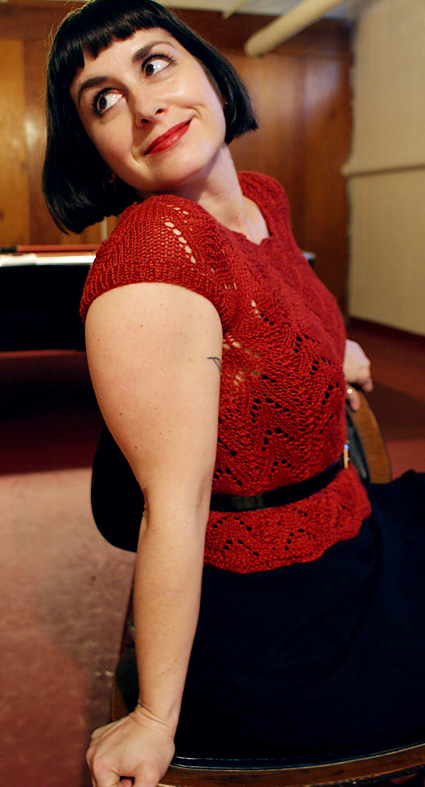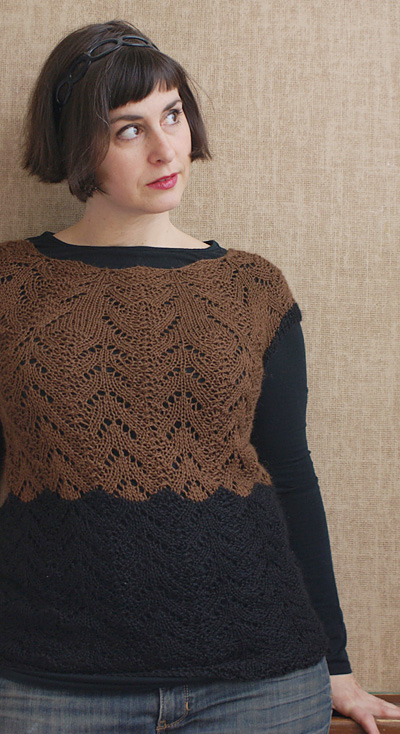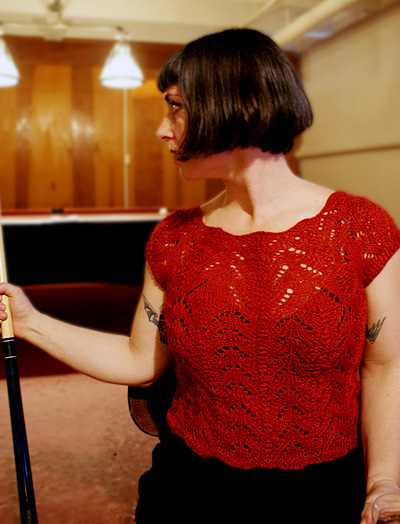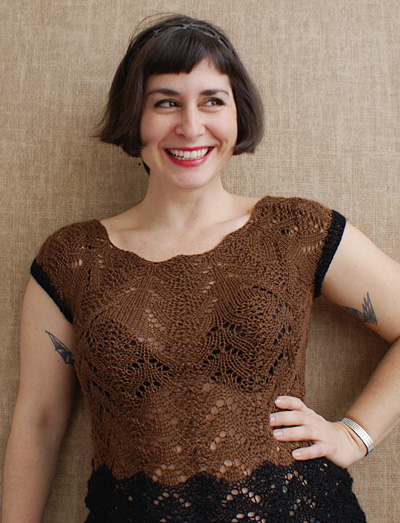

|
|
|

This alpaca and silk top with an all-over lace pattern can be dressed up over a simple camisole or slip dress, or dressed down over a fitted T-shirt and jeans. The two-tone version [see below] feels a bit more casual, but for a special occasion, I’d go with the solid. The seamless, top-down construction and the simple lace pattern make this a gratifying first lace garment. It’s knit in the round top-down, and the yoke is produced with an increasing lace pattern that is worked just as far as necessary for your size. Then it’s divided for the sleeves, and an easily-memorized 8-row, 12-stitch pattern is worked for the rest of the body. The cap sleeves are finished with a bit of ribbing. If you’re substituting yarns, be sure to pick something without memory (in other words, little or no wool), or you’ll have a much clingier garment. To maintain a soft drape, choose fibers like alpaca, silk, cashmere, cotton, Optim, bamboo, etc. The tunic version is quite a long top, so if you’re using a luxury fiber, you can economize yarn and still produce a beautiful garment with the shorter version. |
||

|
Tweet
|
|
|
SIZE |
|
|
FINISHED MEASUREMENTS |
 Yarn Blue Sky Alpacas Alpaca Silk [50% alpaca, 50% silk; 146yd/133m per 50g skein] Shell: 2[2, 3, 3, 4, 5, 6] skeins Two-color tunic: 2[2, 2, 3, 3, 4, 5] skeins each color Notions GAUGE |
|
PATTERN NOTES |
|
Since this sweater is worked from the top down, it can be tried on as it is worked. However, note that the piece will be very different after blocking; the fabric will grow both lengthwise and widthwise, and its drape will change significantly. p3tog: Purl next 3 sts together. 1x1 Rib (Worked in the round over an even number of sts): Instructions for the Backward Loop Cast
On can be found here |
The chart for this pattern is very large and fits on a letter-sized page. Click here and print the resulting page. |
|
DIRECTIONS 
Using medium-sized 16-inch circular needle or double-point needles, CO 120 sts; for two-color tunic, use MC. Place marker and join to begin working in the round, being careful not to twist. Work Rounds 1 through 23[23, 35, 35, 38, 38, 38] of Chart A, switching to longer circular needle when necessary. 160[160, 200, 200, 240, 240, 240] sts. Sizes 1X, 2X, 3X Only: Size 3X Only: All Sizes: Divide Sleeves from Body: LOWER BODY Sizes XS, M, 1X, 3X Only: Sizes S, L, 2X Only: All Sizes: Note: For many sizes, the lace pattern for the lower body will not align directly with the lace pattern in the yoke. For size S only, the lace pattern will align differently for the lower front and back of this sweater; however, both front and back will be symmetrical. Important: In the directions below, length measurements are given for piece stretched 25% lengthwise. The fabric will grow in length by approximately this amount during blocking.
For two-color tunic, continue in pattern until work measures 5[5, 6, 7, 8, 9, 10] inches from underarm, ending with Round 7 of chart. Break MC; continue in pattern using CC. For shell, continue in pattern until work measures 12[14, 16, 18, 18, 20, 20] inches or desired length at center back, ending with Round 8 of chart. For tunic, continue in pattern until work measures 20[22, 24, 26, 27, 28, 28] inches or desired length at center back, ending with Round 8 of chart. P 1 round.
 Note: For two-color tunic, begin sleeve using MC. Place 32[32, 40, 40, 48, 48, 56] held sts of one sleeve on medium-sized 16-inch circular needle or double-point needles. With RS facing, pick up and k 14[8, 14, 14, 26, 14, 38] sts along underarm edge; this will be 1 st in each CO st and 1 st at each corner, in gap between held sts and underarm sts. Place marker at end of picked-up sts; k all held sts, place marker to indicate beginning of round. 46[40, 54, 54, 74, 62, 94] sts. Next Round: Ssk, k to 2 sts before marker, k2tog, slip marker, work Round 25[25, 37, 37, 15, 15, 17] of Chart A[A, A, A, A, A, B] to end of round. 44[38, 52, 52, 72, 60, 92] sts. Sizes XS, M, 1X, 3X Only: Sizes S, L, 2X Only: All Sizes: |
|
FINISHING |

|
| ABOUT THE DESIGNER |
|
|
|
Pattern & images © 2011 Nikol Lohr. Contact Nikol |